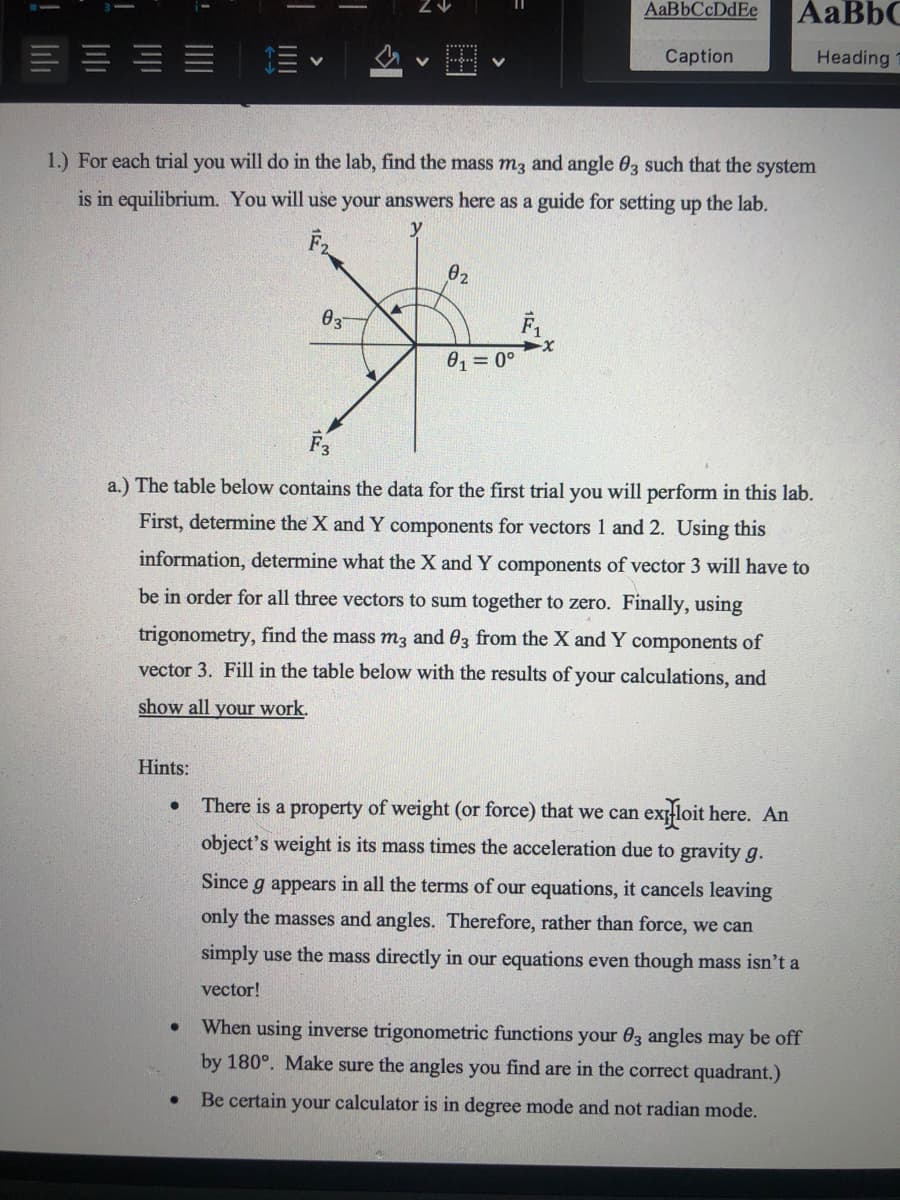1.) For each trial you will do in the lab, find the mass m3 and angle 03 such that the system is in equilibrium. You will use your answers here as a guide for setting up the lab. 02 03 0, = 0° F3 a.) The table below contains the data for the first trial you will perform in this lab. First, determine the X and Y components for vectors 1 and 2. Using this information, determine what the X and Y components of vector 3 will have to be in order for all three vectors to sum together to zero. Finally, using trigonometry, find the mass m3 and 03 from the X and Y components of vector 3. Fill in the table below with the results of your calculations, and show all your work. Hints: There is a property of weight (or force) that we can exloit here. An object's weight is its mass times the acceleration due to gravity g. Since g appears in all the terms of our equations, it cancels leaving only the masses and angles. Therefore, rather than force, we can simply use the mass directly in our equations even though mass isn't a vector! When using inverse trigonometric functions your 03 angles may be off by 180°. Make sure the angles you find are in the correct quadrant.) Be certain your calculator is in degree mode and not radian mode.
1.) For each trial you will do in the lab, find the mass m3 and angle 03 such that the system is in equilibrium. You will use your answers here as a guide for setting up the lab. 02 03 0, = 0° F3 a.) The table below contains the data for the first trial you will perform in this lab. First, determine the X and Y components for vectors 1 and 2. Using this information, determine what the X and Y components of vector 3 will have to be in order for all three vectors to sum together to zero. Finally, using trigonometry, find the mass m3 and 03 from the X and Y components of vector 3. Fill in the table below with the results of your calculations, and show all your work. Hints: There is a property of weight (or force) that we can exloit here. An object's weight is its mass times the acceleration due to gravity g. Since g appears in all the terms of our equations, it cancels leaving only the masses and angles. Therefore, rather than force, we can simply use the mass directly in our equations even though mass isn't a vector! When using inverse trigonometric functions your 03 angles may be off by 180°. Make sure the angles you find are in the correct quadrant.) Be certain your calculator is in degree mode and not radian mode.
Related questions
Question
Use the directions in photo 1 to answer the chart/fill in, in photo 2

Transcribed Image Text:1.) For each trial you will do in the lab, find the mass m3 and angle 03 such that the system
is in equilibrium. You will use your answers here as a guide for setting up the lab.
02
03
0, = 0°
F3
a.) The table below contains the data for the first trial you will perform in this lab.
First, determine the X and Y components for vectors 1 and 2. Using this
information, determine what the X and Y components of vector 3 will have to
be in order for all three vectors to sum together to zero. Finally, using
trigonometry, find the mass m3 and 03 from the X and Y components of
vector 3. Fill in the table below with the results of your calculations, and
show all your work.
Hints:
There is a property of weight (or force) that we can
exloit here. An
object's weight is its mass times the acceleration due to gravity g.
Since g appears in all the terms of our equations, it cancels leaving
only the masses and angles. Therefore, rather than force, we can
simply use the mass directly in our equations even though mass isn't a
vector!
When using inverse trigonometric functions your 03 angles may be off
by 180°. Make sure the angles you find are in the correct quadrant.)
Be certain your calculator is in degree mode and not radian mode.

Expert Solution
This question has been solved!
Explore an expertly crafted, step-by-step solution for a thorough understanding of key concepts.
This is a popular solution!
Trending now
This is a popular solution!
Step by step
Solved in 5 steps
